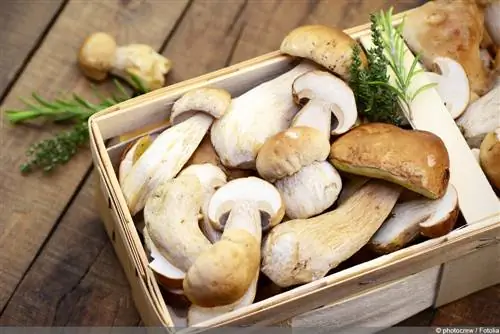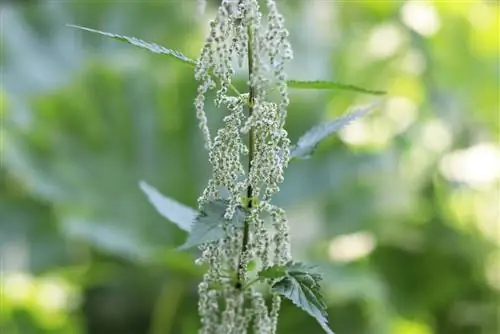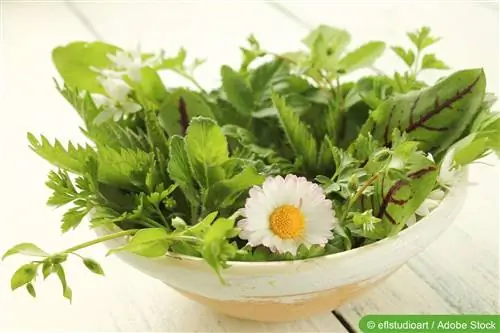- Author admin [email protected].
- Public 2023-12-17 03:39.
- Last modified 2025-01-24 12:45.
The warm, humid weather of late summer heralds the porcini mushroom season for many mushroom lovers. Many people are now looking for the popular edible mushrooms and are almost professionally searching certain areas of the forest. However, if you are not familiar with mushroom hunting, you will not only search in vain, but you may also pick up the wrong mushroom. You can find out here what you need to pay attention to when looking for mushrooms and how you can then prepare and preserve the noble mushroom!
When is porcini mushroom season?
Basically, mushrooms can grow all year round. However, the best time for collecting and therefore the season for porcini mushrooms is from late summer to autumn - more precisely from July to October. But this period alone is no guarantee for a successful mushroom hunt. Experienced mushroom pickers know that the weather and time also have a significant impact on mushroom hunting. If you want to find as many mushrooms as possible, you should pay attention to the following:
- Mushrooms love warm, humid weather
- preferably rainy a few days before
- as early as possible in the morning
- It's best to be in the forest at sunrise
What is needed for mushroom hunting?
If you want to go looking for the popular edible mushrooms, you should first equip yourself. The mushrooms should not only be picked professionally, but also transported afterwards. This is the only way to ensure that the mushrooms arrive home safely and can be processed further without any problems. It is therefore advisable to equip yourself as follows for mushroom hunting:
- Basket or cloth bag
- no plastic bag
- small knife or pocket knife
- sturdy shoes
- Mobile Phone
- Emergency kit
- Take your identification book with you if necessary
Tip:
For mushroom pickers there are special mushroom knives that have a brush at the end. This allows you to clean the mushrooms immediately after picking them.
Where do porcini mushrooms grow?
The noble mushroom prefers to grow in forests, both deciduous and coniferous. This of course results in a correspondingly large search area. However, if you want to find as many porcini mushrooms as possible, look in certain places. Many fungi live in close symbiosis with other plants, which means they receive more minerals, for example. The noble mushroom also has preferred and unloved neighbors, so that mushroom collectors can search more specifically:
- common in spruce trees
- and on sandy soils
- on moss or heather
- not for jewelweed or nettles
Tip:
Mushrooms often grow in the same areas over and over again. It is therefore advisable to mark these areas on a map.
Identifying porcini mushrooms
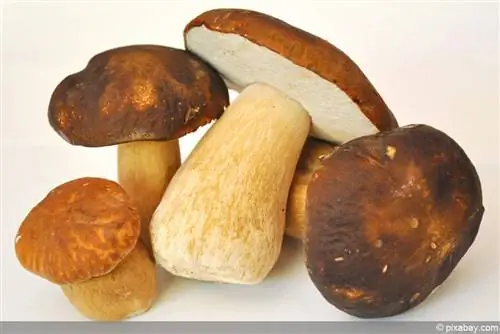
The porcini mushroom is relatively well known, so many mushroom lovers can easily recognize it visually. However, even experienced mushroom pickers cannot always identify it at first glance. Sometimes different types of mushrooms only differ based on the smallest features, which are only apparent at second glance. Whether the mushroom found is actually a boletus can be seen from the following features:
- Hat: 5-25 cm wide
- white in young specimens, later light to dark brown
- Tubes: first white, then greenish-yellow
- can be easily removed from the hat meat
- Stem: 7-15 cm high, 3-6 cm thick
- gray-white or gray-brownish
- Meat: white and firm
- nutty, mild taste
Caution, risk of confusion
Some types of mushrooms are visually very similar to noble mushrooms, so it can happen that they are confused. If a chestnut bolet ends up in the basket instead of the supposed porcini mushroom, it's usually not a big deal. The chestnut boletus is also an edible mushroom and can be eaten without hesitation. This can also be seen directly when cutting, as the interface turns bluish.
However, the situation is different with gallbladder, which not only tastes bitter but is also inedible in large quantities. The reason for this is the hydrogen cyanide it contains, which can lead to stomach and intestinal problems. However, the gall bolete can be distinguished from the porcini mushroom based on certain characteristics:
- light to dark brown
- very fine felty
- Hat is initially spherical
- later bulging and fleshy
- recognizable net on a stick
Tip:
To tell whether it is a porcini mushroom or a gall bolete, simply lick the cut surface of the mushroom. If the mushroom tastes sour or bitter, then it is a gall mushroom. By the way, the saliva should not be swallowed afterwards, but spit out!
Which porcini mushrooms to pick?
If the porcini mushroom is identified as such, that does not mean that it should be picked. The location as well as the age and condition of the fungus play an important role. Ideally, the mushroom grows in a forested area, is completely intact and middle-aged. However, if the fungus has the following characteristics, it is better to leave it in place:
- soggy and frozen mushrooms
- mouldy specimens
- especially young ones: are difficult to determine
- too old: are soft and spongy
- Mushrooms on the side of the road: heavy metal pollution
Tip:
While these mushrooms are inedible for humans, they are of great importance for the forest's existence. Because they serve as food for snails, maggots and game.
Picking porcini mushrooms correctly
Anyone who has found a porcini mushroom should not simply tear it out of the ground by force. This could damage the fungus. However, how the noble mushroom is ultimately picked depends on various factors:
- Porcini mushrooms can be cut off
- best just below the style base
- Unscrewing the mushroom is also possible
- then tap the resulting hole
Tip:
If you are not sure whether the specimen you have found is a boletus, you should pry it out. This means the fruiting body is not damaged, which makes the fungus easier to identify.
Quality Control
Before the picked porcini mushroom ends up in the basket, it should be subjected to a quality control. This ensures that the mushroom is actually intact and he althy. To do this, the fungus is first cleaned of any remaining soil and then checked as follows:
- Checking the sponge under the hat
- ideally it is firm and yellowish
- Remove brown-greenish sponge
- also if it is easily dented
- Cut out food marks generously
- Cut the mushroom lengthwise
- check for maggots and other pests
How many porcini mushrooms to pick?
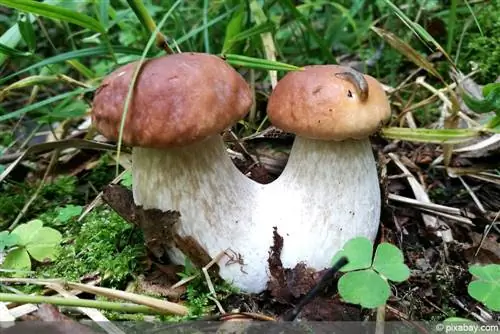
Basically, it is advisable to only collect mushrooms in quantities that can be consumed shortly after picking. Because they are not suitable for keeping fresh for longer periods of time. In addition, the permitted amount is regulated by law and is even controlled in some places! If you have discovered a large number of popular edible mushrooms, you should not collect them all at once. The following guidelines apply by law:
- 2 kilograms of porcini mushrooms allowed per day and per person
- Group of 4 people can harvest a maximum of 8 kilograms
Transportation
Ideally, the porcini mushrooms are placed in a basket or cloth bag while they are being collected. It is important that the mushrooms are stored as airy and cool as possible. Otherwise, they may spoil in a very short time. To ensure that the mushrooms survive the journey home safely, the following should be noted:
- do not store in an overheated car
- keep as cool as possible
- get home as quickly as possible
Cleaning porcini mushrooms
Ideally, the mushrooms are freed of coarse dirt and cleaned as soon as they are picked. However, it is not a problem if they are cleaned at home. The mushrooms have to be cleaned anyway before they end up in the cooking pot or freezer. To clean them, proceed as follows:
- Cut off moss residue and forest floor at the end of the cut
- remove any needles
- cut out damaged areas and traces of corrosion
- Clean up any remaining soil with a kitchen towel
- Cut the mushroom in half lengthwise and check for maggots or worms
Preparing porcini mushrooms
The edible mushrooms can be processed into a wide variety of dishes, such as simply frying them. In combination with a few herbs and fried bacon cubes, you can conjure up a tasty dish that is also suitable for beginner cooks. If you want to fry them, you need about 400 grams of firm porcini mushrooms, a few parsley leaves, fresh herbs and a little butter. You can season it as desired, but seasoning with s alt and pepper is usually enough. The edible mushrooms are prepared as follows:
- Cut mushrooms into 0.5 cm thick slices
- Heat oil in pan
- Spread the mushroom slices in it
- fry over medium heat for about 2 minutes
- season with s alt and pepper
- Stir in butter
- Sprinkle parsley over it
- add fresh herbs if necessary
Drying porcini mushrooms
The edible mushrooms are not suitable for keeping fresh for a long time, but they can be dried without any problems. This means they not only last longer, but also have a more intense taste. There are different options for drying the edible mushrooms. On the one hand, they can be dried in the oven at around 40 degrees. It is important to ensure that the oven is not completely closed. It is best to wedge a wooden spoon into the door so that it is open a crack. As an alternative to the oven, drying in the fresh air is also possible:
- Mushrooms must not be wet - danger of mold
- so don't wash the mushrooms beforehand!
- then cut into slices about 3 mm thick
- best with an egg slicer
- Spread the mushroom pieces on a horde or gauze
- are not allowed to touch each other
- as dry, hot weather as possible
- shady spot is ideal
Note:
If the mushrooms are dried outdoors, they should be brought indoors overnight. Otherwise they could draw moisture again, which promotes mold and rot.
Freezing porcini mushrooms
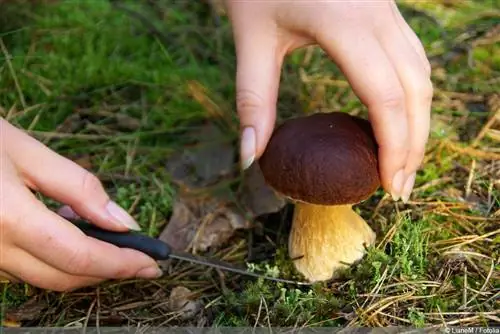
An alternative to drying is freezing the mushrooms. What is practical here is that both fresh and fully cooked mushrooms can be frozen. The latter are simply filled into a freezer-safe container and then placed in the freezer. The situation is different with fresh mushrooms, because they must first be prepared:
- Cleaning mushrooms
- Add to boiling water for 2-3 minutes
- then add some lemon juice
- prevents discoloration
Tip:
Do not thaw frozen mushrooms, but process them straight away!
Shelf life and storage
After picking, the edible mushrooms can easily be stored in the refrigerator for a few days. To do this, they are filled into an air-permeable container and placed in the vegetable compartment. If the mushrooms are frozen, they will last for up to six months. Dried porcini mushrooms, on the other hand, can be enjoyed even longer if they are stored properly. Because here it is important to note the following:
- closed container
- ideally darkened vessel
- dark, dry location

